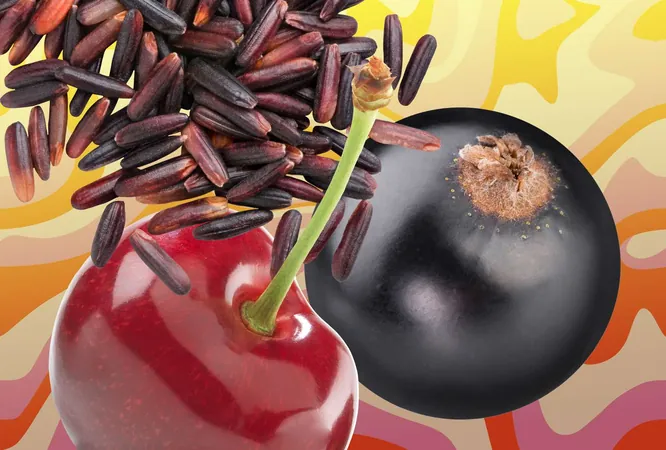
Unlock the Power of Color: 5 Foods Packed with More Anthocyanins Than Blueberries!
2025-05-04
Author: Benjamin
When it comes to nutrient-rich superfoods, blueberries often steal the limelight. Known for their delicious flavor and impressive health benefits—including improved heart health and reduced inflammation—these little berries owe their vibrant blue hue to a powerful antioxidant: anthocyanins.
But don’t let blueberries have all the fun! A variety of other stunning red, blue, and purple foods are equally loaded with anthocyanins and often pack even more of this potent antioxidant. Curious about how to enhance your diet with these colorful gems? We consulted dietitians to highlight five fabulous foods that provide a bigger anthocyanin punch than your favorite blueberries!
1. Blackberries: The Darker the Berry, the More the Benefit!
Blackberries are not only deliciously sweet, but they also deliver a robust dose of anthocyanins, ranging from 100 to 138 milligrams per 100 grams. As dietitian Alison Ellis, M.Sc., RD, notes, many blackberry varieties can rival or even surpass blueberries in antioxidants. Plus, they’re higher in fiber—nearly double that of blueberries—making them a fantastic addition to any diet. Toss them into a fruit salad or sprinkle them on your morning toast for that extra health boost!
2. Black Currants: The Unsung Hero of Antioxidants!
Prepare to meet the super berry: black currants! Packed with between 113 to 158 milligrams of anthocyanins per 100 grams, these small, tart berries are a powerhouse of antioxidants. As Bess Berger, RDN, points out, adding black currants to your diet not only enhances flavor but also fortifies your body against oxidative stress and supports heart health. Though they may be hard to find fresh in stores, don’t underestimate the power of black currant jam on your toast!
3. Cherries: More Than Just a Summer Treat!
If cherry season has you excited, you’ll be delighted to know that sweet cherries (a.k.a. black cherries) are a treasure trove of anthocyanins, boasting 169 milligrams per 100 grams. These juicy fruits not only taste great, but they’re also excellent for fighting inflammation and provide a dose of vitamin C. Enjoy them as a snack or incorporate them into a cherry-almond farro salad for a nutritious twist!
4. Elderberry: The Tiny Berry with Huge Benefits!
Elderberries often top the charts for anthocyanin content, flaunting an astounding 485 milligrams per 100 grams. However, consume them with caution: raw elderberries can be toxic! Typically found in jams, syrups, and supplements, elderberries are excellent for immune support. Why not make your own elderberry syrup to mix into tea or sparkling water and reap the rewards of this mighty berry?
5. Black Rice: An Unexpected Nutritional Powerhouse!
Don’t forget pantry staples! Black rice, also known as forbidden rice, boasts anthocyanin levels around 456 milligrams per 100 grams. Its deep purple hue is a natural indicator of its antioxidant-rich content. Alongside anthocyanins, black rice is high in fiber, iron, and various minerals. Try incorporating it into flavorful dishes like coconut black rice bowls with tofu or zesty citrus shrimp!
In summary, don’t settle for just blueberries when it comes to your berry fix! Embrace the rainbow of red, blue, and purple foods around you—each brimming with anthocyanins. Branch out with blackberries, black currants, cherries, elderberries, and black rice. Your taste buds (and body) will thank you!









 Brasil (PT)
Brasil (PT)
 Canada (EN)
Canada (EN)
 Chile (ES)
Chile (ES)
 Česko (CS)
Česko (CS)
 대한민국 (KO)
대한민국 (KO)
 España (ES)
España (ES)
 France (FR)
France (FR)
 Hong Kong (EN)
Hong Kong (EN)
 Italia (IT)
Italia (IT)
 日本 (JA)
日本 (JA)
 Magyarország (HU)
Magyarország (HU)
 Norge (NO)
Norge (NO)
 Polska (PL)
Polska (PL)
 Schweiz (DE)
Schweiz (DE)
 Singapore (EN)
Singapore (EN)
 Sverige (SV)
Sverige (SV)
 Suomi (FI)
Suomi (FI)
 Türkiye (TR)
Türkiye (TR)
 الإمارات العربية المتحدة (AR)
الإمارات العربية المتحدة (AR)